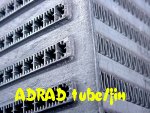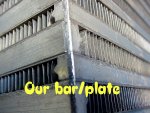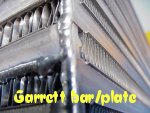
Our newest tank on the left, a typical oppositions tank on
the right. These are 2.5" pipes.
|

Note the venturie effect of our tank with
a totally smooth transition into the pipe. Almost eliminates
turbulence & eddying ! |

Easy to see both the increase -ed area &
radius of our tank. The charge air starts turning much
sooner, in & especially out. |

That sharp edge of the other tanks really
hurts flow and increases pressure drop. |
Not often can we
offer a superior product at a cheaper price - but here it is.
When we first
introduced our Chilli tanks in 1999, they were a revolution, & as of
2003, is still nothing like them on the market. There were over 100
hours development in the first tank & I have spent hundreds of hours
since, to the point that the programme has now been shelved until a
new development comes too light, & I imagine it will have to be
radical! We have reached the stage where we can not improve on them
any more, from these tanks that we are making available now.
Up to now, I have not uploaded any pictures of the inside of our
tanks, to try to protect our research, but the problem is that a
potential customer didn't get the chance to make an educated choice
- and that's what this site is all about ! The tanks are so
refined now, that the internal angles vary between each size (& it
does make a difference), so good luck to anyone who thinks they can
get close to our performances, let alone improve on them !!! That's
why we've now made the large investment in the patterns & moulds.
I got the idea from the intake ports of some of the high compression
turbo engines of the early nineties (& current LS1 Chev.) & from
some of the varied air flow testing I've done over the years.
What the hell am I rambling on about ? The raised triangulated
roof of our tanks of course. This single feature does many
things to enhance the performance of our intercoolers.
Firstly, it allows the intake charge to turn up the long tank radius
early with less turbulence & eddying, resulting in less pressure
drop.
Second it pulls (directs) the charge air around the corner & up the
tank causing some pressure drop (not often can you get something for
nothing) !
Thirdly, the pressure drop is very small & far outweighed by the
advantage of more even distribution across the core face (window),
especially when the inlet/outlet are in line - both top or bottom,
&/or the taller the core. Yes, the pressure is equal throughout the
core, but this is does not mean the airspeed through each tube is
the same !
Fourthly, in the outlet tank, the small pressure drop it causes in
number two, is far outweighed by the huge gain in flow into the
outlet pipe. This is a real venturie effect, enhanced by the early
radius on the long tank side, with no losses at all. A win win.
Check these pictures & it's so obvious.
|










